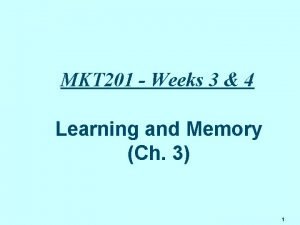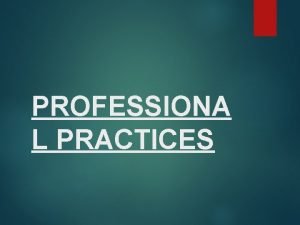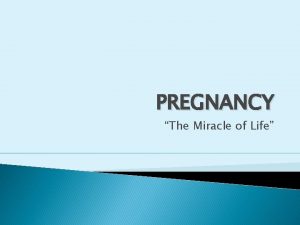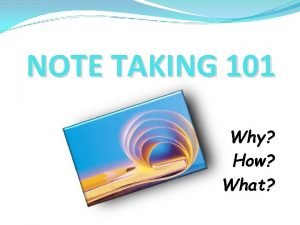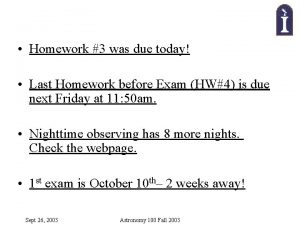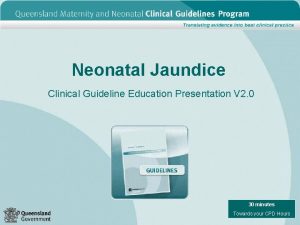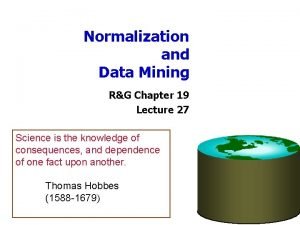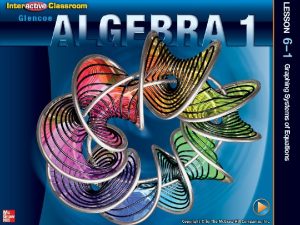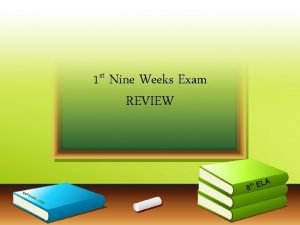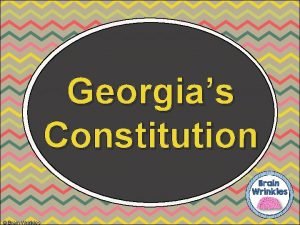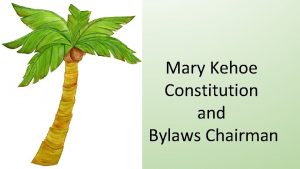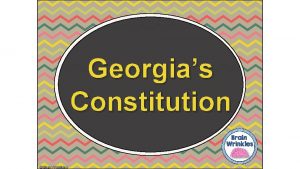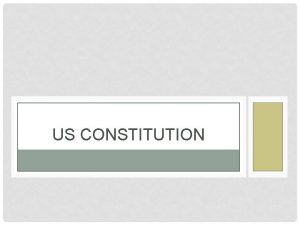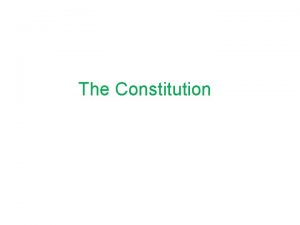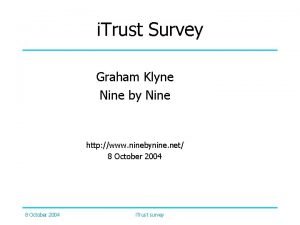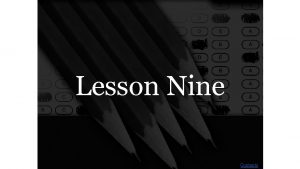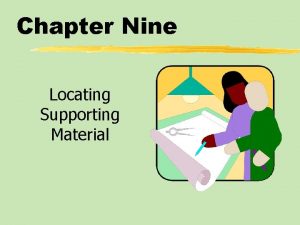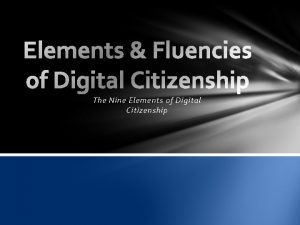1 ST NINE WEEKS EXAM U S Constitution



























- Slides: 27

1 ST NINE WEEKS EXAM

U. S. Constitution & Federalism Checks & Balances Powers of Government Three Branches 10 10 10 20 20 20 30 30 30 40 40 40 50 50 50

U. S. Constitution – 10 Points QUESTION: • Describe how Montesquieu’s view of separation of powers is demonstrated in the U. S. Constitution. ANSWER: • Montesquieu’s view of separation of powers is demonstrated by; the three branches, legislative, executive and judicial dividing federal power. • Three Branches

U. S. Constitution – 20 Points QUESTION: • Which constitutional principle is reflected in this statement? ANSWER: • Separation of Powers

U. S. Constitution – 30 Points QUESTION: According to Article I of the Constitution, how is the Legislative Branch organized? ANSWER: • Congress is bicameral, it is divided into two houses. • Senate and House of Representatives

U. S. Constitution – 40 Points QUESTION: • What is a federal system of government? ANSWER: • Power in the government is divided among the Federal, State and Local Governments.

U. S. Constitution – 50 Points QUESTION: • Describe the purpose of the Preamble of the U. S. Constitution. ANSWER: • The purpose of the Preamble is to state the goals of the constitution as well as the purpose of the government.

Constitution & Federalism– 10 Points QUESTION: • The Preamble of the Constitution provides many goals for the government, describe 2 goals. ANSWER: • Establish Justice – Guarantee Justice for all citizens • Insure Domestic Tranquility – Insure a peaceful nation • Provide for the Common Defense – Defend our nation • Promote the General Welfare – Keep citizens safe and healthy • Secure the Blessings of Liberty – Protect rights for future generations • Form a More Perfect Union – Continue to improve our constitution and government

Constitution & Federalism– 20 Points QUESTION: • What is the Federal System? What does federalism require citizens to do? ANSWER: • The Federal System is the division of power between the Federal (National) Government and the State Government. • Federalism requires citizens to follow both Federal and State laws.

Constitution & Federalism– 30 Points QUESTION: • What are the levels of the Federal system? ANSWER: • Federal/National Government, State Government, Local Government

Constitution & Federalism– 40 Points QUESTION: • Which level of government has the authority to raise an army? Which branch has this power? ANSWER: • Federal: Legislative Branch

Constitution & Federalism– 50 Points QUESTION: • Explain the goals of Articles I, II, and III of the U. S. Constitution. ANSWER: • Article I- Creates the Legislative Branch, makes it a bicameral legislature, power to make laws • Article II- Creates the Executive Branch, power to enforce laws • Article III- Creates the Judicial Branch, power to check laws and actions to make sure they are constitutional. (Judicial Review)

Checks & Balances– 10 Points QUESTION: • What check does the Legislative Branch have on the Executive Branch? ANSWER: • Refuse to ratify treaties • Declare laws unconstitutional • Impeach President • Refuse to approve Presidential appointments

Checks & Balances– 20 Points QUESTION: • Which is an example of checks and balances, according to the U. S. Constitution? • A. Congress appoints a Supreme Court Justice • B. The President vetoes an act of Congress • C. Congress rules a law unconstitutional • D. The Supreme Court overrides a veto ANSWER: • B. The President vetoes an act of Congress

Checks & Balances– 30 Points QUESTION: • What need does this passage refer to? • A. a strong executive branch • B. an inderpendent military • C. a national education system • D. a system of checks and balances ANSWER: • D. a system of checks and balances

Checks & Balances– 40 Points QUESTION: • What check does the Judicial Branch have on the Legislative Branch? ANSWER: • Declaring laws created by Congress unconstitutional

Checks & Balances– 50 Points QUESTION: • What checks to judicial branch power does the legislative branch have? ANSWER: • Congress has the power to impeach federal Judges. • Senate accepts or rejects appointments of federal judges.

Powers of Government– 10 Points QUESTION: • Define Rule of Law, and describe why rule of law is so important in American government. ANSWER: • Rule of Law – All people must follow the law, regardless of race, gender, status, or position. • Rule of law is important because in ensures that the government does not abuse its power and that fair laws apply to everybody the same way.

Powers of Government– 20 Points QUESTION: • What are Reserved, Concurrent and Expressed Powers? ANSWER: • Reserved Powers- Are powers reserved for the states • Concurrent Powers- Powers that are shared by the Federal and State • Expressed Powers – Powers for the Federal Government written in the constitution.

Powers of Government– 30 Points QUESTION: • A bill was passed. It was vetoed. The veto was overridden. Three years later the law was found to be unconstitutional. According to the scenario, in what order did the branches of government exercise their power? ANSWER: • Legislative Branch, Executive Branch, Legislative Branch, Judicial Branch

Powers of Government– 40 Points QUESTION: • Provide an example of each type of power: • Expressed • Reserved • Concurrent ANSWER: • Expressed (Federal) – Declare War, Make Treaties, Coin Money, Make Treaties • Concurrent (Both) – Collect Taxes, Establish Courts, Maintain Roads • Reserved (State) – Marriage, Divorce, Birth, Death, School

Powers of Government– 50 Points QUESTION: • Contrast the differences between the two types of Congressional Power: Expressed power and Implied power. ANSWER: • Expressed Powers- Powers clearly stated in the Constitution given to the federal government. • Implied Powers – Powers that are given to the federal government which are not stated in the constitution, but are necessary for expressed powers.

Three Branches – 10 Points QUESTION: • What type of power is Congress using when they draft citizens in the armed forces? • A. expressed power • B. legislative power • C. implied power • D. enumerated power ANSWER: • C. Implied Power

Three Branches – 20 Points QUESTION: • Senators serve a _______ year term, while representatives serve a ______ year term. ANSWER: • 6, 2

Three Branches – 30 Points QUESTION: • How does congress adjust the number of seats in the House of Representatives, that each state has? ANSWER: • Congress adjusts the number of seats based on population. They use the census every 10 years.

Three Branches – 40 Points QUESTION: • How many total members are in Congress? How many are in each house? ANSWER: • 535 total members • 435 members in the House of Representatives • 100 members in the Senate

Three Branches – 50 Points QUESTION: Step 1: Citizens, Congress or the President comes up with an idea ANSWER: Step 2: Step 3: The House of Representatives Approves the Bill Step 4: The Bill Goes to the Senate for Approval Step 5: The President can approve or veto the bill • Step 2: A Representative has to introduce the bill to the House of Representatives
 3rd 9 weeks exam review chemistry
3rd 9 weeks exam review chemistry Lesson 1 principles of the constitution
Lesson 1 principles of the constitution Texas constitution vs us constitution
Texas constitution vs us constitution Nc constitution vs us constitution
Nc constitution vs us constitution Constitution what is constitution
Constitution what is constitution 201 weeks
201 weeks Covering letter for resignation
Covering letter for resignation 4 weeks before christmas
4 weeks before christmas This weeks lesson
This weeks lesson Mems microfluidics
Mems microfluidics Flocabul;ary
Flocabul;ary Antenatal investigations
Antenatal investigations 8 weeks pregnant ultrasound
8 weeks pregnant ultrasound Zygote weeks
Zygote weeks Rhyming words with mystery
Rhyming words with mystery According to walter pauk, 10 weeks after lecture
According to walter pauk, 10 weeks after lecture Iron core
Iron core 6 weeks of lent
6 weeks of lent Chittibabu and chinnababu live in atreyapuram town in
Chittibabu and chinnababu live in atreyapuram town in Cough for 3 weeks
Cough for 3 weeks Neonatal jaundice
Neonatal jaundice Normalization in data mining
Normalization in data mining Weeks of supply formula
Weeks of supply formula Bma bank holiday lieu days
Bma bank holiday lieu days How many weeks
How many weeks 4 weeks before christmas
4 weeks before christmas 8 weeks embryo
8 weeks embryo Structures derived from pharyngeal arches
Structures derived from pharyngeal arches





